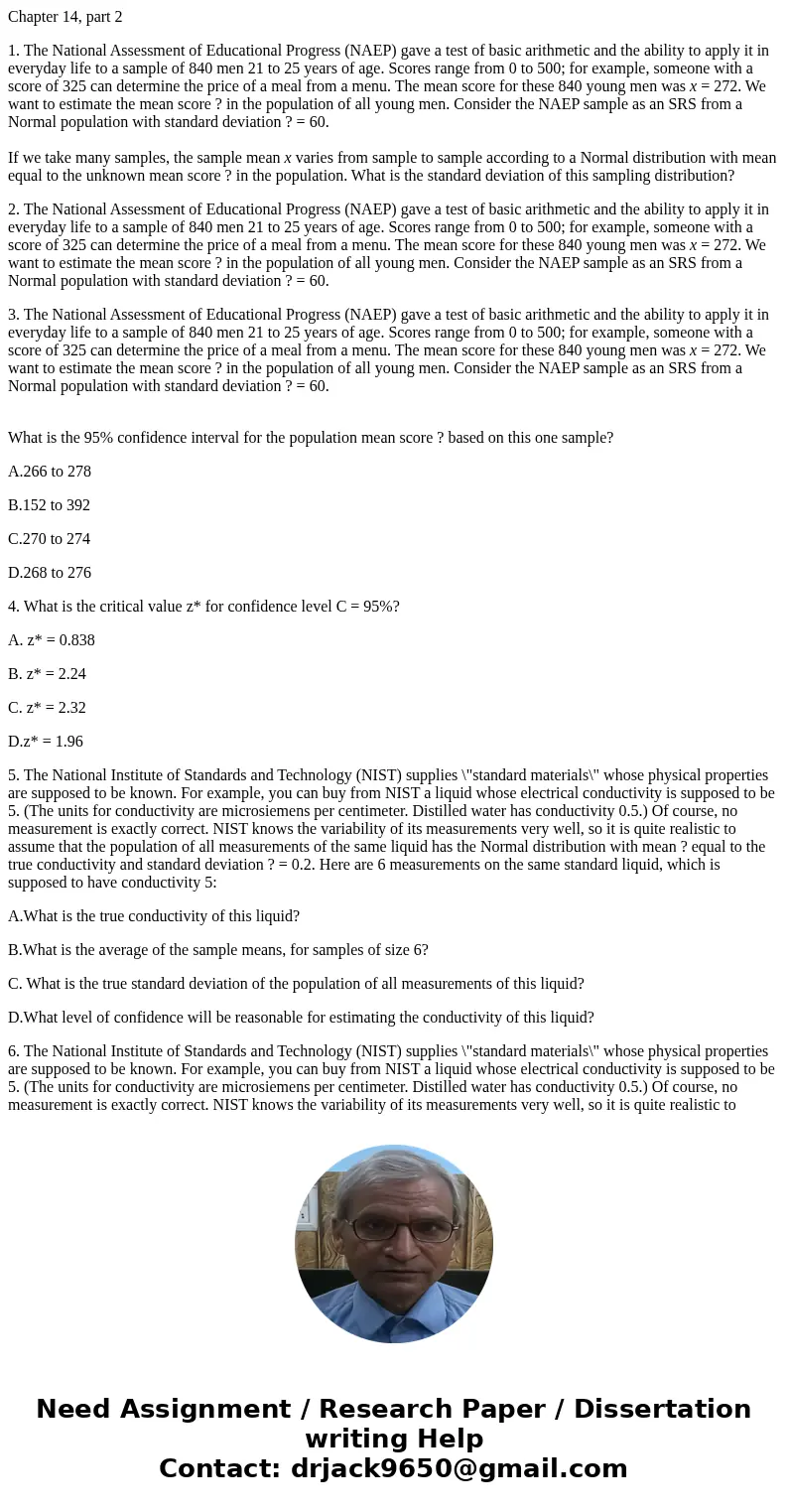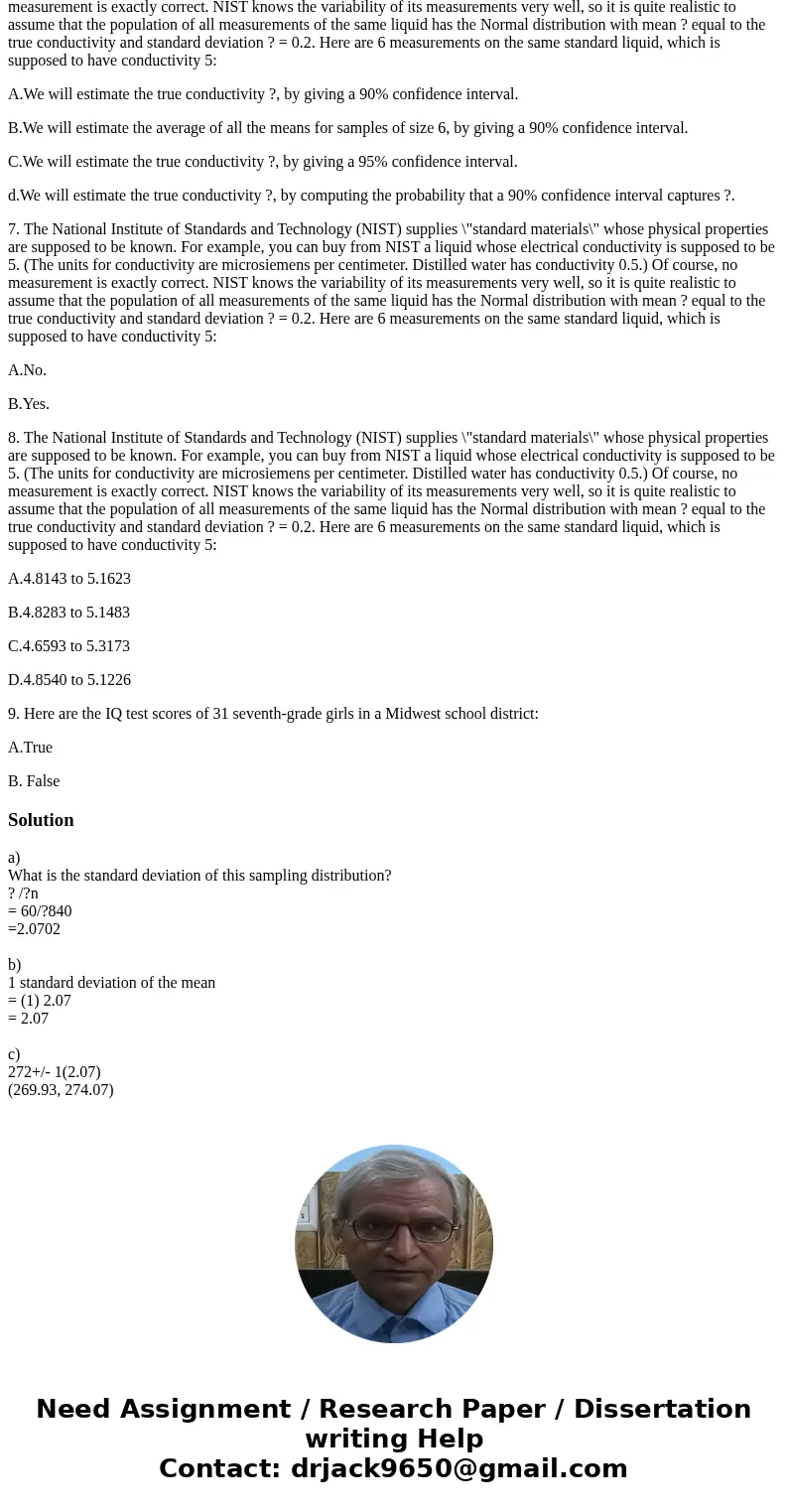Chapter 14 part 2 1 The National Assessment of Educational P
Chapter 14, part 2
1. The National Assessment of Educational Progress (NAEP) gave a test of basic arithmetic and the ability to apply it in everyday life to a sample of 840 men 21 to 25 years of age. Scores range from 0 to 500; for example, someone with a score of 325 can determine the price of a meal from a menu. The mean score for these 840 young men was x = 272. We want to estimate the mean score ? in the population of all young men. Consider the NAEP sample as an SRS from a Normal population with standard deviation ? = 60.
If we take many samples, the sample mean x varies from sample to sample according to a Normal distribution with mean equal to the unknown mean score ? in the population. What is the standard deviation of this sampling distribution?
2. The National Assessment of Educational Progress (NAEP) gave a test of basic arithmetic and the ability to apply it in everyday life to a sample of 840 men 21 to 25 years of age. Scores range from 0 to 500; for example, someone with a score of 325 can determine the price of a meal from a menu. The mean score for these 840 young men was x = 272. We want to estimate the mean score ? in the population of all young men. Consider the NAEP sample as an SRS from a Normal population with standard deviation ? = 60.
3. The National Assessment of Educational Progress (NAEP) gave a test of basic arithmetic and the ability to apply it in everyday life to a sample of 840 men 21 to 25 years of age. Scores range from 0 to 500; for example, someone with a score of 325 can determine the price of a meal from a menu. The mean score for these 840 young men was x = 272. We want to estimate the mean score ? in the population of all young men. Consider the NAEP sample as an SRS from a Normal population with standard deviation ? = 60.
What is the 95% confidence interval for the population mean score ? based on this one sample?
A.266 to 278
B.152 to 392
C.270 to 274
D.268 to 276
4. What is the critical value z* for confidence level C = 95%?
A. z* = 0.838
B. z* = 2.24
C. z* = 2.32
D.z* = 1.96
5. The National Institute of Standards and Technology (NIST) supplies \"standard materials\" whose physical properties are supposed to be known. For example, you can buy from NIST a liquid whose electrical conductivity is supposed to be 5. (The units for conductivity are microsiemens per centimeter. Distilled water has conductivity 0.5.) Of course, no measurement is exactly correct. NIST knows the variability of its measurements very well, so it is quite realistic to assume that the population of all measurements of the same liquid has the Normal distribution with mean ? equal to the true conductivity and standard deviation ? = 0.2. Here are 6 measurements on the same standard liquid, which is supposed to have conductivity 5:
A.What is the true conductivity of this liquid?
B.What is the average of the sample means, for samples of size 6?
C. What is the true standard deviation of the population of all measurements of this liquid?
D.What level of confidence will be reasonable for estimating the conductivity of this liquid?
6. The National Institute of Standards and Technology (NIST) supplies \"standard materials\" whose physical properties are supposed to be known. For example, you can buy from NIST a liquid whose electrical conductivity is supposed to be 5. (The units for conductivity are microsiemens per centimeter. Distilled water has conductivity 0.5.) Of course, no measurement is exactly correct. NIST knows the variability of its measurements very well, so it is quite realistic to assume that the population of all measurements of the same liquid has the Normal distribution with mean ? equal to the true conductivity and standard deviation ? = 0.2. Here are 6 measurements on the same standard liquid, which is supposed to have conductivity 5:
A.We will estimate the true conductivity ?, by giving a 90% confidence interval.
B.We will estimate the average of all the means for samples of size 6, by giving a 90% confidence interval.
C.We will estimate the true conductivity ?, by giving a 95% confidence interval.
d.We will estimate the true conductivity ?, by computing the probability that a 90% confidence interval captures ?.
7. The National Institute of Standards and Technology (NIST) supplies \"standard materials\" whose physical properties are supposed to be known. For example, you can buy from NIST a liquid whose electrical conductivity is supposed to be 5. (The units for conductivity are microsiemens per centimeter. Distilled water has conductivity 0.5.) Of course, no measurement is exactly correct. NIST knows the variability of its measurements very well, so it is quite realistic to assume that the population of all measurements of the same liquid has the Normal distribution with mean ? equal to the true conductivity and standard deviation ? = 0.2. Here are 6 measurements on the same standard liquid, which is supposed to have conductivity 5:
A.No.
B.Yes.
8. The National Institute of Standards and Technology (NIST) supplies \"standard materials\" whose physical properties are supposed to be known. For example, you can buy from NIST a liquid whose electrical conductivity is supposed to be 5. (The units for conductivity are microsiemens per centimeter. Distilled water has conductivity 0.5.) Of course, no measurement is exactly correct. NIST knows the variability of its measurements very well, so it is quite realistic to assume that the population of all measurements of the same liquid has the Normal distribution with mean ? equal to the true conductivity and standard deviation ? = 0.2. Here are 6 measurements on the same standard liquid, which is supposed to have conductivity 5:
A.4.8143 to 5.1623
B.4.8283 to 5.1483
C.4.6593 to 5.3173
D.4.8540 to 5.1226
9. Here are the IQ test scores of 31 seventh-grade girls in a Midwest school district:
A.True
B. False
Solution
a)
What is the standard deviation of this sampling distribution?
? /?n
= 60/?840
=2.0702
b)
1 standard deviation of the mean
= (1) 2.07
= 2.07
c)
272+/- 1(2.07)
(269.93, 274.07)


 Homework Sourse
Homework Sourse